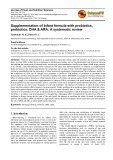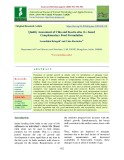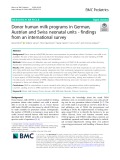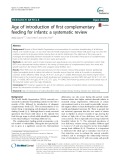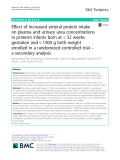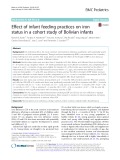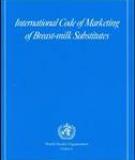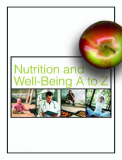
Breast milk feeding
-
There are recommendations to guide parents to help their infants make the transition from milk to weaning foods, but they differ in their focus in developed or developing countries and on the physiological and behavioral reasons that underlie the introduction of weaning foods.
 10p
10p  viisac
viisac
 23-09-2023
23-09-2023
 7
7
 0
0
 Download
Download
-
Promotion of optimal growth in infants calls for introduction of adequate food supplements in the form of complementary foods in addition to continued breast feeding from the age of 6 months onwards as complementary feeding plays critical role in children. Study was carried out to develop complementary food formulation, sensory evaluation, nutrient and antinutrients analysis. Finger millet, oilseeds, milk solids, jaggery, processed chia seeds and basella alba leaves were used in different proportion.
 10p
10p  caygaocaolon6
caygaocaolon6
 30-07-2020
30-07-2020
 14
14
 4
4
 Download
Download
-
Milk fat globule membranes (MFGM) have shown to have functional components that are found in human milk, suggesting that addition of bovine sources of MFGM (bMFGM) to infant formula may promote beneficial outcomes potentially helping to narrow the gap between infants who receive human breast milk or infant formula.
 11p
11p  viorochimaru2711
viorochimaru2711
 29-05-2020
29-05-2020
 6
6
 0
0
 Download
Download
-
Donor human milk (DHM) has been recommended for premature infants if mothers’ own milk is not available. The aim of this study was to increase the knowledge about the utilization rate and handling of DHM among neonatal units in Germany, Austria und Switzerland.
 7p
7p  viorochimaru2711
viorochimaru2711
 29-05-2020
29-05-2020
 10
10
 0
0
 Download
Download
-
Fortified human milk may not meet all nutritional needs of very preterm infants. Early transition from complementary parenteral nutrition to full enteral feeds might further impair in-hospital growth.
 4p
4p  vinatri2711
vinatri2711
 29-02-2020
29-02-2020
 17
17
 1
1
 Download
Download
-
Despite a World Health Organization recommendation for exclusive breastfeeding of all full-term infants to 6 months of age, it is not clear what the health implications may be. Breast milk alone may not meet the nutrition needs for all growing infants, leaving them at risk for deficiencies.
 11p
11p  vichengshin2711
vichengshin2711
 26-02-2020
26-02-2020
 15
15
 1
1
 Download
Download
-
Feeding breast milk is associated with reduced morbidity and mortality, as well as improved neurodevelopmental outcome but does not meet the high nutritional requirements of preterm infants. Both plasma and urinary urea concentrations represent amino acid oxidation and low concentrations may indicate insufficient protein supply.
 8p
8p  vidr2711
vidr2711
 19-02-2020
19-02-2020
 24
24
 1
1
 Download
Download
-
Iron deficiency (ID) is the most common micronutrient deficiency worldwide, with potentially severe consequences on child neurodevelopment. Though exclusive breastfeeding (EBF) is recommended for 6 months, breast milk has low iron content.
 9p
9p  vidr2711
vidr2711
 19-02-2020
19-02-2020
 14
14
 1
1
 Download
Download
-
Considering that, when mothers do not breast-feed, or only do so partially, there is a legitimate market for infant formula and for suitable ingredients from which to prepare it; that all these products should accordingly be made accessible to those who need them through commercial or non-commercial distribution systems; and that they should not be marketed or distributed in ways that may interfere with the protection and promotion of breast-feeding; Recognizing further that inappropriate feeding practices lead to infant malnutrition, morbidity and mortality in all countries, and tha...
 12p
12p  doiroimavanchuadc
doiroimavanchuadc
 06-02-2013
06-02-2013
 49
49
 3
3
 Download
Download
-
A variety of factors influence the prevalence and duration of breast-feeding. The Twenty-seventh World Health Assembly, in 1974, noted the general decline in breast-feeding in many parts of the world, related to sociocultural and other factors including the promotion of manufactured breast-milk substitutes, and urged "Member countries to review sales promotion activities on baby foods to introduce appropriate remedial measures, including advertisement codes and legislation where necessary".1 The issue was taken up again by the Thirty-first World Health Assembly in May 1978.
 24p
24p  doiroimavanchuadc
doiroimavanchuadc
 06-02-2013
06-02-2013
 31
31
 3
3
 Download
Download
-
Nutrition is one of the most important factors that impact health in all areas of the lifecycle. Pregnant women need adequate food and health care to deliver a healthy baby who has a good birth weight and a fighting chance for survival. In many regions of the world, the infant mortality rate is very high, meaning that many infants will not live to see their first birthday. Breastfeeding is the ideal method of feeding and nurturing infants, because breast milk contains many immunologic agents that protect the infant against bacteria, viruses, and parasites.
 627p
627p  cronus75
cronus75
 14-01-2013
14-01-2013
 81
81
 20
20
 Download
Download
-
In the United States, women who are HIV positive and are aware of that fact are advised not to breast-feed their infants. Chemicals present in breast milk act together, with time and cold temperatures, to destroy the HIV present in expressed breast milk. The risk to childcare providers who feed children bottles of expressed breast milk is extremely low because the risk of transmission from skin/mucous membrane exposures to HIV is extremely low (probably much lower than...
 106p
106p  le_minh_nha
le_minh_nha
 12-12-2012
12-12-2012
 58
58
 4
4
 Download
Download
CHỦ ĐỀ BẠN MUỐN TÌM








